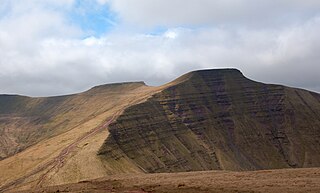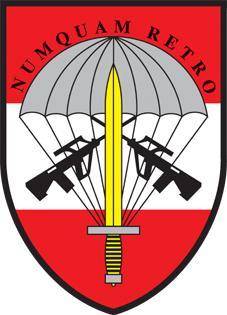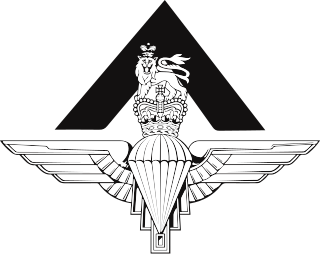
The Brecon Beacons are a mountain range in Wales. The range includes South Wales's highest mountain, Pen y Fan, its twin summit Corn Du, and Craig Gwaun Taf, which are the three highest peaks in the range. The Brecon Beacons have given their name to the larger Brecon Beacons National Park, and the range itself is therefore sometimes known as the Central Beacons to differentiate the two.

The 1st Special Forces Operational Detachment–Delta, referred to as Delta Force, Combat Applications Group (CAG), or within Joint Special Operations Command (JSOC), Task Force Green, is a special operations force of the United States Army, under operational control of JSOC. The unit's missions primarily involve counterterrorism, hostage rescue, direct action, and special reconnaissance, often against high-value targets.

The 1st Commando Regiment is an Australian Army Reserve special forces unit, part of Special Operations Command with an integrated structure of regular (full-time) soldiers and reserve (part-time) soldiers, which together with the full-time Australian Army 2nd Commando Regiment, provides the commando capability to Special Operations Command. 1st and 2nd Commando companies were raised in 1955 and were combined with 126 Signal Squadron (SF) in 1981 to form the 1st Cdo Regt. The regiment's two commando companies are the oldest sub-units within Special Operations Command. In 2008, the regiment deployed to Afghanistan to become the first Australian Army Reserve force element on combat operations since World War II. The regiment is the Command's capability lead for special warfare.

The Ranger School is a 62-day United States Army small unit tactics and leadership course that develops functional skills directly related to units whose mission is to engage the enemy in close combat and direct fire battles. Ranger training was established in September 1950 at Fort Benning, Georgia. The Ranger course has changed little since its inception. Until recently, it was an eight-week course divided into three phases. The course is now 61 days in duration and divided into three phases as follows: Benning Phase, Mountain Phase, and Swamp Phase.

The Jagdkommando is the Austrian Armed Forces' special forces unit. The unit is based at Wiener Neustadt and is known to have a manpower of 400 operators.

The Pathfinder Platoon is a pathfinder unit of the British Army, and an integral part of 16 Air Assault Brigade. The Pathfinder Platoon acts as the brigade's advance force and reconnaissance force. Its role includes locating and marking drop zones and helicopter landing zones for air landing operations. Once the main force has landed, the platoon provides tactical intelligence and offensive action roles for the brigade.

The United States Marine Corps Officer Candidates School (OCS) is a training regiment designed to screen and evaluate potential Marine Corps Officers. Those who successfully complete the period of instruction are commissioned as Second Lieutenants in the United States Marines. Unlike the other United States military services, the majority of Marine Corps officers complete OCS to earn a commission; the exceptions are midshipmen from the United States Naval Academy, limited duty officers and warrant officers, and inter-service transfers. It is located at Marine Corps Base Quantico.

The All Arms Commando Course (AACC) lasts for 13 weeks and is run by the Royal Marines at the Commando Training Centre Royal Marines (CTCRM), Lympstone. Members from any of the United Kingdom's Regular Armed Forces and overseas exchange personnel can attend to serve with 3 Commando Brigade. On completion of the course the successful candidate earns the right to wear the green beret, and to wear the "Commando Dagger" on their uniform. The Royal Marines expect that nearly half of the volunteers will drop out or be dismissed before completing the AACC. The primary aim of the course is to give service personnel the core military skills necessary for Extremely and Very High readiness Commando and Littoral Strike operations.
UK Joint Special Forces Selection is the selection and training process for candidates of the United Kingdom Special Forces: Special Air Service, Special Boat Service, and Special Reconnaissance Regiment. Members of the SAS and SBS undergo selection up to the award of a sand-coloured beret to SAS personnel, whereupon SBS candidates undergo further selection to qualify as Swimmer Canoeists, and SAS personnel undergo further specialist training. SRR candidates undergo the Aptitude Phase, before going on to their own specialist covert surveillance & reconnaissance training.

United States Army Basic Combat Training (BCT) is the recruit training program of the United States Army, for service in the U.S. Army, U.S. Army Reserve, or the Army National Guard.

Pegasus Company is a training and selection organisation of the British Armed Forces based at the Infantry Training Centre, Catterick, North Yorkshire. P Coy run the 'Pre-Parachute Selection' courses for Parachute Regiment recruits and regular and reserve personnel from across the UK armed forces who volunteer to serve in a parachute role within 16 Air Assault Brigade.

The Marine Corps Security Force Regiment is a dedicated expeditionary security and anti-terrorism regiment of the United States Marine Corps. Its mission is to provide security forces to guard high-value naval installations, most notably those containing nuclear vessels and weapons. Additionally, it also provides the Fleet Anti-terrorism Security Teams (FAST) and Recapture Tactics Teams (RTT). Marines who complete Security Forces training are assigned a secondary Military Occupational Specialty (MOS) of 8152, while instructors can earn 8153.

American Ninja Warrior is an American sports entertainment reality show based on the Japanese television reality show Sasuke, which also serves as a successor of American Ninja Challenge. It features a set of obstacle courses in various cities, which contestants attempt to conquer. The obstacle courses are divided into Qualifiers courses, Semifinals courses, and a four-part Finals course which is based at Las Vegas Strip. The contestant who finishes all the courses in the fastest time wins a cash prize of $1,000,000. Starting with season 10, if one remaining contestant fails on any of Finals course parts but has completed it more than the others in the fastest time, they win a consolatory $100,000 prize. The show is hosted by Matt Iseman and Akbar Gbaja-Biamila. To date, only Isaac Caldiero, Drew Drechsel, and Vance Walker have won the main cash prize. Furthermore, Geoff Britten and Daniel Gil are the only two runners-up who have achieved Total Victory.

The average member of the United States Navy's Sea, Air, Land Teams (SEALs) spends over a year in a series of formal training environments before being awarded the Special Warfare Operator Naval Rating and the Navy Enlisted Classification (NEC) O26A Combatant Swimmer (SEAL) or, in the case of commissioned naval officers, the designation 113X Special Warfare Officer. All Navy SEALs must attend and graduate from their rating's 24-week "A" School known as Basic Underwater Demolition/SEAL (BUD/S) school, a basic parachutist course and then the 26-week SEAL Qualification Training program.

The 75th Ranger Regiment's Regimental Reconnaissance Company is an elite special operations force that has been a member of Joint Special Operations Command (JSOC) since 2005. The unit is believed to have become part of JSOC due to its extensive training and unique capabilities to conduct special reconnaissance and close target reconnaissance (CTR) operations, and advanced force operations (AFO).
Royal Marines recruit training is the longest basic modern infantry training programme of any Commonwealth, or North Atlantic Treaty Organization (NATO) combat troops. The Royal Marines are the only part of the British Armed Forces where officers and other ranks are trained at the same location, the Commando Training Centre Royal Marines (CTCRM) at Lympstone, Devon. Much of the basic training is carried out on the rugged terrain of Dartmoor and Woodbury Common with a significant proportion taking place at night.

1 Parachute Battalion is the only full-time paratroop unit of the South African Army. It was founded on 1 April 1961, along with the Parachute Battalion. The name of this unit was changed to Parachute Training Centre after 1998. It was the first battalion within 44 Parachute Brigade until 1999 when the brigade was downsized to 44 Parachute Regiment

The Army Reserve Officer Training Corps (AROTC) is the United States Army component of the Reserve Officers' Training Corps. It is the largest Reserve Officer Training Corps (ROTC) program which is a group of college and university-based officer training programs for training commissioned officers for the United States Army and its reserves components: the Army Reserves and the Army National Guard. There are over 30,000 Army ROTC cadets enrolled in 274 ROTC programs at major universities throughout the United States. These schools are categorized as Military Colleges (MC), Military Junior Colleges (MJC) and Civilian Colleges (CC).

4 South African Infantry Battalion is a motorised infantry unit of the South African Army.

8 South African Infantry Battalion is a mechanized infantry unit of the South African Army. The battalion is equipped with Ratel Infantry Fighting Vehicles (IFV) used for fast transport and combat mobility across rough ground. Support weapons for mechanized infantry are also provided with motorized transport, or are built directly into these IFVs, in order to keep pace with the IFVs in combat. The battalion was raised at Upington in the Northern Cape in 1973 as part of the South African Infantry Corps, and since the change in structure, has been assigned to the Infantry Formation.


















